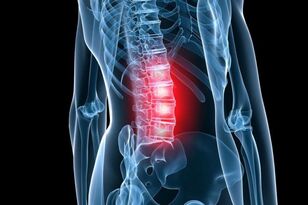
Low back pain plagues many people, regardless of their age and occupation. Loaders and office workers, young mothers and retired gardeners, writers and even athletes have all suffered. In either case, pathological changes may occur in the bones and cartilage tissues of the vertebrae, resulting in compression (compression) of the nerve and spinal cord roots, causing severe pain.
But the painful feeling is only the external manifestation of the disease. It is often accompanied by other pathological syndromes that require mandatory treatment. Without these syndromes, it usually leads to disability and self-care ability. In other words, a person becomes disabled.
Disease description
Osteochondrosis is caused by unnatural compression of the spine. Compression of the spine causes compression of the intervertebral disc and adjacent tissues of the ligament device. When squeezing, the liquid will leave the intervertebral disc, which is the cause of the plasticity of the intervertebral disc, and is the source of tissue nutrition, with necessary trace elements. With long-term negative effects, the annulus of the intervertebral disc loses elasticity and density, and then breaks, resulting in compression of nerve endings. This becomes the cause of pain, usually accompanied by edema.
In addition, the outer edges of the vertebrae (with incorrect load distribution) became overgrown with osteophytes-bone tissue growth. They also damage and restrict the movement of the spine, exacerbating the problem.
That is, this disease most often occurs in the load on the spine, which is not properly distributed or stereotyped-monotonous and often repeated.
Cause of occurrence
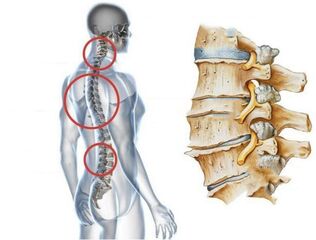
Don't think that only vigorous physical exercise or a sedentary lifestyle (weakened muscle frame) will cause lumbar osteochondrosis. This can also happen to very active people who are engaged in sports activities or work in summer houses every day. If their movement is monotonous (lifting the barbell, digging the ground), there will be pressure at the same point where the cartilage tissue is gradually destroyed.
There are other reasons. Where:
- Destroy calcium metabolism in the body;
- Overweight or severe fluctuations in any direction, strict diet, pregnancy, rapid changes in hormone levels;
- Spinal injury or curvature (scoliosis);
- A severe hypothermia or frequent exposure to cold, humid environment;
- Depression, stress;
- Continuous physical overload;
- Bad inheritance.
Attention. Any strict diet based on using a product or strictly reducing calorie intake will not only lead to a sharp drop in weight, but also lead to a lack of precious trace elements in the body. This is also harmful to muscles and bones.
Symptoms

Osteochondrosis is rarely detected in time because it is asymptomatic at the beginning. More precisely, there are symptoms, but it is difficult to associate with spinal disease. Therefore, when conducting a comprehensive examination of other health problems, they are most often found accidentally.
Disease development is divided into four stages. Let us describe the symptoms of each.
| Stage | Description |
|---|---|
| First | In the first stage, the sweating process is interrupted and a person notices general discomfort and rapid fatigue. Some patients talk about previous abnormal foot cold. |
| seconds | In the second stage, intermittent back pain occurs, indicating the beginning of destruction of cartilage tissue. |
| Third place | The third stage is characterized by visible changes. Intervertebral hernias may occur, the spine is often curved, and humps may appear in some cases. |
| Fourth place | The fourth stage is the most difficult stage because there is no need to talk about a complete cure due to irreversible changes in the bones. In addition to the proliferation of osteophytes and the displacement of the vertebrae can cause acute pain, other organs of the pelvis can also have problems. Usually the patient will stop controlling the process of urination and defecation. |
Disease treatment
Choose the treatment of rickets according to the stage of the disease and the severity of the pain. Conservative treatment can only bring good results in the early stages. For example, if you catch lumbar osteochondrosis at the beginning, you can get rid of it through special physical exercises, correct physical activity and weight, swim, and take vitamin and mineral complex preparations.
This is no longer enough when pain occurs. It must be deleted along with the reason for its occurrence. Why use drugs, traditional physiotherapy techniques or even alternative methods? And in the later stages, only surgical treatment is possible.
Physical Therapy
In order to relieve pain and swelling, enhance the effect of drugs and reduce dosage, such hardware physical therapy methods are used as:
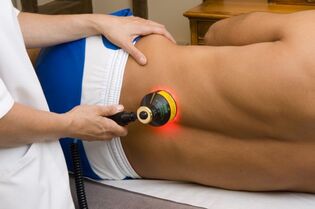
- ultrasound;
- Laser;
- Magnetic field effect;
- Electrophoresis;
- Manual therapy, massage.
Attention. Massage helps relieve muscle spasms, improve blood circulation in the affected intervertebral disc area, and release compressed blood vessels and nerves. This operation can only be done with the help of hands, but vacuum massage is contraindicated in this disease.
Shockwave therapy
The key is that the shock wave destroys osteophytes and restores cartilage tissue. However, the healthy bones of the spine and the main arteries can also be damaged. Therefore, it is very important to ensure that the technology is well developed in the hospital and treated by highly qualified and licensed experts.
Alternative treatment methods
In addition to the standard treatment of lumbar osteochondrosis, there are also non-traditional methods. This method is under continuous research and has been applied in many clinics. These mainly include:
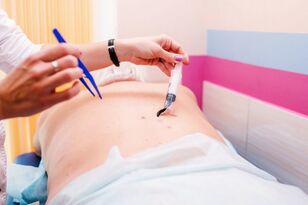
- Hand rheumatism or hydro-ech therapy can help relieve inflammation and improve blood circulation;
- Acupuncture is an effective way to relieve pain, muscle tension and inflammation. It includes the introduction of special needles into certain biologically active points of the body.
- Ozone therapy-injection of ozone-oxygen mixture. With the correct dosage, this method can inhibit the growth of osteophytes and relieve painful muscle tone.
Parallel to these treatment methods or recording the results obtained with their help, exercise therapy and therapeutic gymnastics courses were conducted.
Surgical technique
If the disease starts and conservative treatment does not relieve the patient's condition, they will resort to surgery. If after months of active treatment, you cannot get rid of the pain and cannot improve the patient's overall condition, then you cannot live without them. Especially in the case of decreased male strength, ruptured pelvic organs, and perineal numbness.
- Endoscopic microscopic discectomy-remove the herniated disc. This is a minimally invasive surgery that reduces compression of the spinal cord or nerve roots.
- It is difficult to call laser reconstruction of the intervertebral disc surgery. During the operation under local anesthesia, a thin needle is inserted into the affected intervertebral disc and the needle is irradiated with a laser to stimulate chondrocytes to divide.
- Foraminotomy is an operation that removes part of the vertebrae or intervertebral discs to release compressed nerves.
- Vertebroplasty-bone cement is injected into the damaged vertebral tissue to increase its strength.
- Osteotomy-removal of diseased vertebrae and intervertebral discs, and then replaced with prostheses.
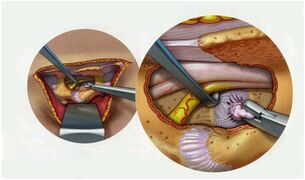
There are other ways to stabilize the vertebrae, decompress them, and remove osteophytes. Any one of them requires a longer recovery period. After surgical treatment of the spine, the patient should not get up for a long time, walk, bend over or be under physical pressure. This leads to muscle relaxation and partial loss of motor function, which requires support and rehabilitation. Therefore, at the end of the postoperative period, the recovery and rehabilitation period begins, and its task is to fully restore motor function and prevent complications from the pelvic organs.
At this stage, some of the above conservative treatment methods were applied, the correct posture was developed, and the habitual exercise was corrected. In this case, patients are advised to wear a special corset. Thereafter, a separate set of exercises will be developed, which should be performed every day for life to prevent recurrence of the disease.

























